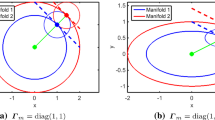Abstract
The proper orthogonal decomposition (POD) method is used to construct a set of basis functions for spanning the ensemble of data in a certain least squares optimal sense. Compared with the singular value decomposition (SVD), the POD basis functions can capture more energy in the forecast ensemble space and can represent its spatial structure and temporal evolution more effectively. After the analysis variables are expressed by a truncated expansion of the POD basis vectors in the ensemble space, the control variables appear explicitly in the cost function, so that the adjoint model, which is used to derive the gradient of the cost function with respect to the control variables, is no longer needed. The application of this new technique significantly simplifies the data assimilation process. Several assimilation experiments show that this POD-based explicit four-dimensional variational data assimilation method performs much better than the usual ensemble Kalman filter method on both enhancing the assimilation precision and reducing the computation cost. It is also better than the SVD-based explicit four-dimensional assimilation method, especially when the forecast model is not perfect and the forecast error comes from both the noise of the initial filed and the uncertainty of the forecast model.
Similar content being viewed by others
References
Lewis L, Deber J. The use of adjoint equation to solve a variational adjustment problem with advective constraint. Tellus Ser A-Dyn Meteorol Oceanol, 1985, 37: 309–322
Le Dimet F X, Talagrand O. Variational algorithms for analysis and assimilation of meteorological observations: Theoretical aspects. Tellus Ser A-Dyn Meteorol Oceanol, 1986, 38: 97–110
Xu Q. Generalized adjoint for physical processes with parameterized discontinuities. Part I: Basis issues and heuristic examples. J Atmos Sci, 1996, 53(8): 1123–1142
Mu M, Wang J. A method for adjoint variational data assimilation with physical “on-off” processes. J Atmos Sci, 2003, 60: 2010–2018
Kalnay E, Park S K, Pu Z X, et al. Application of the quasi-inverse method to data assimilation. Mon Weather Rev, 2000,128: 864–875
Wang B, Zhao Y. A new data assimilation approach (in Chinese). Acta Meteorol Sin, 2005, 63: 694–700
Courtier P, Thepaut J N, Hollingsworth. A strategy for operational implementation of 4D-Var using an incremental approach. Q J R Meteorol Soc, 1994, 120: 1367–1388
Evensen G. Sequential data assimilation with a non-linear geostrophic model using Monte Carlo methods to forecast error statistics. J Geophys Res, 1994, 99(C5): 10143–10162
Hamill T M, Snyder C. A hybrid ensemble Kalman Filter-3D Variational analysis scheme. Mon Weather Rev, 2000, 128: 2905–2919
Lorenc A C. Modelling of error covariances by 4D-Var Variational data assimilation. Q J R Meteorol Soc, 2003, 129: 3167–3182
Qiu C J, Chou J F. Four-dimensional data assimilation method based on SVD: Theoretical aspect. Theor Appl Climatol, 2006, 83: 51–57
Qiu C J, Zhang L, Shao A M. An explicit four-dimensional variational data assimilation method. Sci China Ser D-Earth Sci, 2007, 50(8): 1232–1240
Ly H V, Tran H T. Proper orthogonal decomposition for flow calculations and optimal control in a horizontal CVD reactor. Q Appl Math, 2002, 60(3): 631–656
Ly H V, Tran H T. Modeling and control of physical processes using proper orthogonal decomposition. Math Comput Model, 2001, 33: 223–236
Cao Y H, Zhu J, Navon I M. A reduced order approach to four-dimensional variational data assimilation using proper orthogonal decomposition. Int J Numer Methods Fluids. 2007, 53(10): 1571–1583
Oleson K W, Dai Y J, Bonan G, et al. Technical Description of the Community Land Model (CLM). Technical Report, Terrestrial Sciences Section, Climate and Global Dynamics Divison, National Center for Atmospheric Research, 2004. 186
Darcy H. Les Fontaines Publiques de la Ville de Dijon, Dalmont, Paris. 1856
Author information
Authors and Affiliations
Corresponding author
Additional information
Supported by the National Natural Science Foundation of China (Grant No. 40705035), National High Technology Research and Development Program of China (Grant No. 2007AA12Z144), Knowledge Innovation Project of Chinese Academy of Sciences (Grant Nos. KZCX2-YW-217 and KZCX2-YW-126-2), and National Basic Research Program of China (Grant No. 2005CB321704)
Rights and permissions
About this article
Cite this article
Tian, X., Xie, Z. An explicit four-dimensional variational data assimilation method based on the proper orthogonal decomposition: Theoretics and evaluation. Sci. China Ser. D-Earth Sci. 52, 279–286 (2009). https://doi.org/10.1007/s11430-009-0012-4
Received:
Accepted:
Published:
Issue Date:
DOI: https://doi.org/10.1007/s11430-009-0012-4




